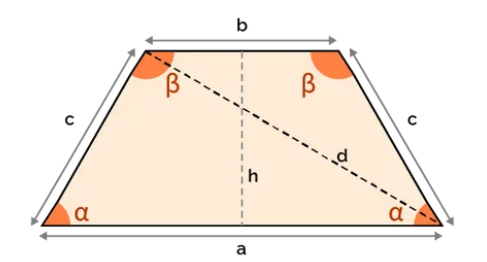1. What is an Isosceles Trapezoid Calculator?
Definition: This calculator computes the height (\( h \)), acute angle (\( \alpha \)), obtuse angle (\( \beta \)), diagonal (\( d \)), perimeter, and area of an isosceles trapezoid using the longer base (\( a \)), shorter base (\( b \)), and leg (\( c \)). An isosceles trapezoid is a quadrilateral with one pair of parallel sides (bases) and non-parallel sides (legs) of equal length.
Purpose: It aids in geometry education, architectural design, and engineering by calculating key parameters for isosceles trapezoid shapes, such as in roofing, bridges, or structural panels.
2. How Does the Calculator Work?
The calculator uses the following formulas:
- Height: \( h = \sqrt{c^2 - \left(\frac{a - b}{2}\right)^2} \).
- Area: \( A = \frac{(a + b) \cdot h}{2} \).
- Perimeter: \( P = a + b + 2c \).
- Acute Angle (\( \alpha \)): \( \alpha = \arcsin\left(\frac{h}{c}\right) \).
- Obtuse Angle (\( \beta \)): \( \beta = 180^\circ - \alpha \).
- Diagonal (\( d \)): \( d = \sqrt{h^2 + \left(\frac{a + b}{2}\right)^2} \).
Unit Conversions:
- Length Units: m, cm (1 m = 100 cm), mm (1 m = 1000 mm), in (1 m = 39.3701 in), ft (1 m = 3.28084 ft), yd (1 m = 1.09361 yd).
- Area Units: m², cm² (1 m² = 10000 cm²), mm² (1 m² = 1000000 mm²), in² (1 m² = 1550.0031 in²), ft² (1 m² = 10.7639 ft²), yd² (1 m² = 1.19599 yd²).
- Angle Units: Angles are computed and displayed in degrees.
Steps:
- Input the longer base \( a \), shorter base \( b \), and leg \( c \), selecting their units.
- Validate inputs: All inputs must be positive, longer base must be at least as large as shorter base, and leg must be long enough to form a valid trapezoid.
- Convert inputs to meters for calculations.
- Compute the height, acute angle, obtuse angle, diagonal, perimeter, and area using the formulas above.
- Convert length and area outputs to the selected units; angles remain in degrees.
- Format outputs to 4 decimal places or scientific notation for small values.
3. Importance of Isosceles Trapezoid Calculations
Calculating the properties of an isosceles trapezoid is crucial for:
- Geometry Education: Understanding quadrilateral properties, trigonometric relationships, and angle calculations.
- Architecture and Engineering: Determining material requirements and structural integrity for trapezoidal shapes in roofs, bridges, or windows.
- Design: Creating symmetrical trapezoidal elements in aesthetic or functional designs.
4. Using the Calculator
Examples:
- Example 1: Longer base \( a = 10 \, \text{cm} \), Shorter base \( b = 6 \, \text{cm} \), Leg \( c = 5 \, \text{cm} \)
- Convert: \( a = 0.1 \, \text{m} \), \( b = 0.06 \, \text{m} \), \( c = 0.05 \, \text{m} \).
- Height: \( h = \sqrt{0.05^2 - \left(\frac{0.1 - 0.06}{2}\right)^2} \approx 0.04 \, \text{m} = 4.0000 \, \text{cm} \).
- Acute Angle: \( \alpha = \arcsin\left(\frac{0.04}{0.05}\right) \approx 53.1301^\circ \).
- Obtuse Angle: \( \beta = 180 - 53.1301 \approx 126.8699^\circ \).
- Diagonal: \( d = \sqrt{0.04^2 + \left(\frac{0.1 + 0.06}{2}\right)^2} \approx 0.0894 \, \text{m} = 8.9443 \, \text{cm} \).
- Perimeter: \( P = 0.1 + 0.06 + 2 \cdot 0.05 = 0.26 \, \text{m} = 26.0000 \, \text{cm} \).
- Area: \( A = \frac{(0.1 + 0.06) \cdot 0.04}{2} = 0.0032 \, \text{m}^2 = 32.0000 \, \text{cm}^2 \).
- Example 2: Longer base \( a = 8 \, \text{m} \), Shorter base \( b = 4 \, \text{m} \), Leg \( c = 3 \, \text{m} \)
- Height: \( h = \sqrt{3^2 - \left(\frac{8 - 4}{2}\right)^2} \approx 2.2361 \, \text{m} \).
- Acute Angle: \( \alpha = \arcsin\left(\frac{2.2361}{3}\right) \approx 48.1897^\circ \).
- Obtuse Angle: \( \beta = 180 - 48.1897 \approx 131.8103^\circ \).
- Diagonal: \( d = \sqrt{2.2361^2 + \left(\frac{8 + 4}{2}\right)^2} \approx 6.7082 \, \text{m} \).
- Perimeter: \( P = 8 + 4 + 2 \cdot 3 = 18.0000 \, \text{m} \).
- Area: \( A = \frac{(8 + 4) \cdot 2.2361}{2} \approx 13.4166 \, \text{m}^2 \).
5. Frequently Asked Questions (FAQ)
Q: What is an isosceles trapezoid?
A: An isosceles trapezoid is a quadrilateral with one pair of parallel sides (bases) and non-parallel sides (legs) of equal length, with one line of symmetry through the midpoints of the bases.
Q: Why do the acute and obtuse angles sum to 180°?
A: In an isosceles trapezoid, the angles at the base are supplementary to the angles at the top due to the parallel bases and the transversal formed by the legs.
Q: Can the calculator handle any isosceles trapezoid?
A: Yes, as long as the inputs describe a valid isosceles trapezoid (positive inputs, longer base at least as large as shorter base, leg long enough to form a trapezoid), the calculator provides accurate results.
 Home
Home
 Back
Back
